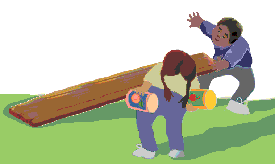|
|
|
|
|
 |
 |
Mar 25,
1999 |

|
Previous Next |
 |
| |
 By Dr. Leila
Gonzalez (and friends) By Dr. Leila
Gonzalez (and friends)
For the last two weeks we have been
exploring the question: “How do ice skaters get spinning so
fast?” I asked you to watch figure skaters and send me a
description of what they do as they start to spin faster. Many of you
observed that the speed of the spin seems to be related to the position
of the skaters' arms; the closer the arms are to the body, the faster
they spin, and the further away, the slower they go. So skaters control
the speed of their spin by changing the positions of their arms (and
also their legs), just as in the simulation in Whyville!
|
 So,
that answers the question “How do skaters control their spin?”
but not the question “Why does this work?” I was very happy
to see that several of you sent in your own ideas about why this works.
Some of you mentioned that it is easier to spin something that is
compact and several others said this could be due to the effect of wind
resistance. You said that when the arms were out, the wind resistance
probably increases, and the skater then slows down. But does this
really explain why the spin increases when the arms are close to the
body? Here’s an experiment we designed that removes wind
resistance as a variable. If we look at two identical things (since
things that are the same shape and texture will each have the same
amount of wind resistance), and we see a difference in how they behave
while spinning (or rolling in this case), there must be something else
going on. I suspect that the conservation of angular momentum has some
effect (just like my physics friend Alicia hinted last week). So,
that answers the question “How do skaters control their spin?”
but not the question “Why does this work?” I was very happy
to see that several of you sent in your own ideas about why this works.
Some of you mentioned that it is easier to spin something that is
compact and several others said this could be due to the effect of wind
resistance. You said that when the arms were out, the wind resistance
probably increases, and the skater then slows down. But does this
really explain why the spin increases when the arms are close to the
body? Here’s an experiment we designed that removes wind
resistance as a variable. If we look at two identical things (since
things that are the same shape and texture will each have the same
amount of wind resistance), and we see a difference in how they behave
while spinning (or rolling in this case), there must be something else
going on. I suspect that the conservation of angular momentum has some
effect (just like my physics friend Alicia hinted last week).
|
 |
Connect to the
Web. This week in the Whyville Spin Lab, you can look directly at the
effects of resistance on spinning figure skaters and all the other new
objects we have left in the lab.
|
 |
Watch March 25th
on CBS, “People of the Century: Great Minds, Great
Discoveries.” Take a look at great thinkers and the methods they
used that led to their discoveries. And on Sunday, March 28th, watch
The Learning Channel’s show about the perils of space travel,
called “Blast Off: True Stories From The Final Frontier.”
Think about how conservation of momentum affects everything, including
rockets, planets, and astronauts walking in space. Then write
me! |
 |
Try
this: Get 2 identical cans of fruit cocktail. Put one of them in the
freezer for 24 hours. Then, you will need a long, wide board (wide
enough for the two cans to roll down side by side without falling off)
and a book (to raise one end of the board). Once your can of fruit
cocktail is frozen, line both cans (frozen and unfrozen) up at the top
of the board, and let them go at EXACTLY the same time. Try this
several times and write down whether one can rolls faster down the board
than the other. Because they are the same shape, any difference you see
in the cans’ rolling speed cannot be due to differences in wind
resistance. Can you figure out what is going on? (Next week we will
finally tell you what we think!)
|
 |
Next week, after
I have read your observations from last week (send them in!), we will
talk about what the conservation of momentum has to do with figure
skaters changing the speed of their spins. (Do you already know? Tell
me!) |
 |
|